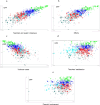Intersecting dimensions: advanced analytical approach to school climate and injury prevention in health policy
- PMID: 39654032
- PMCID: PMC11626754
- DOI: 10.1186/s13584-024-00659-z
Intersecting dimensions: advanced analytical approach to school climate and injury prevention in health policy
Abstract
Background: Child safety in schools is paramount for decision-makers globally, with a focus on ensuring children return home safely. However, the prevalent issue of injuries across educational systems demands a comprehensive investigation into their causes, incorporating interdisciplinary perspectives and social dynamics, to develop effective prevention strategies. The objective of this study is to comprehensively analyze the factors contributing to school-related injuries and examine the impact of school climate on student safety. By employing advanced data analysis techniques, the research aims to develop targeted, effective strategies to enhance child safety in educational settings. This research aims to develop a multidimensional taxonomy to understand child injuries in elementary schools better, enhancing precision in decision-making.
Methods: Data from 363 Israeli primary schools and 10,855 school injuries attended to by MDA, the principal EMS provider, were analyzed. The study utilized a two-level taxonomy, employing clustering methodology to classify schools into distinct climate "patterns," with each pattern further delineating school injury characteristics into sub-patterns. The chosen method proved effective in revealing nuanced relationships between school injuries and climate characteristics.
Results: Analysis revealed five school climate clusters, ranging from "good" to "bad," each exhibiting two homogeneous sub-clusters of school injuries. Schools with a "positive" climate witnessed boys predominantly experiencing head injuries during breaks, while girls often sustained limb injuries from playing in corridors. Conversely, within the "negative" climate cluster, subgroups emerged based on injury nature, whether linked to playing or falling from a height.
Conclusion: The research delineates a nuanced association between school climate and injury rates, emphasizing the necessity for sophisticated analytical techniques beyond conventional methodologies. Utilizing a diverse dataset from various disciplines, the study highlights the multidimensional aspects of school health. The developed taxonomy reveals the complex dynamics within school environments, advocating for customized health policies to mitigate injuries. Critical findings prompt a reevaluation of established assumptions about the school climate-injury relationship, informing strategic policymaking. For example, it suggests collaboration to enhance school safety through targeted, gender-sensitive interventions and improvements. Integrating different data sources offers a holistic understanding crucial for effective health policy formulation in educational contexts.
Keywords: Cluster analysis; Injury prevention; Primary schools; School climate; Taxonomy.
© 2024. The Author(s).
Conflict of interest statement
Declarations. Ethics approval and consent to participate: This study did not require formal ethics approval as it did not involve human subjects, animal subjects, or any sensitive personal data. Consent for publication: Not applicable. Competing interests: The authors declare that they have no competing interests.
Figures
References
-
- Aldridge JM, McChesney K. The relationships between school climate and adolescent mental health and wellbeing: a systematic literature review. Int J Educ Res. 2018;88:121–45. 10.1016/j.ijer.2018.01.012.
-
- Anglin JP. Risk, well-being, and paramountcy in child protection: the need for transformation. Child Youth Care Forum. 2002;31(4):233–55. 10.1023/A:1016303309618.
-
- Benassi M, Garofalo S, Ambrosini F, Sant’Angelo RP, Raggini R, De Paoli G, Ravani C, Giovagnoli S, Orsoni M, Piraccini G. Using two-step cluster analysis and latent class cluster analysis to classify the cognitive heterogeneity of cross-diagnostic psychiatric inpatients. Front Psychol. 2020. 10.3389/fpsyg.2020.01085. - PMC - PubMed
-
- Caruso G, Gattone SA, Fortuna F, Di Battista T. Cluster analysis as a decision-making tool: a methodological review. In: Bucciarelli E, Chen S-H, Corchado JM, editors. Decision economics In: the tradition of herbert a. Simon’s Heritage. Berlin: Springer; 2018. p. 48–55. 10.1007/978-3-319-60882-2_6.
-
- Cavrini G, Chianese G, Bocch B, Dozza L. School climate: parents’, students’ and teachers’ perceptions. Procedia Soc Behav Sci. 2015;191:2044–8. 10.1016/j.sbspro.2015.04.641.
MeSH terms
LinkOut - more resources
Full Text Sources
Medical
Research Materials



